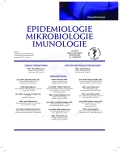In-vivo interspecies transmission of carbapenemase KPC in a long-term treated female patient
Authors:
P. Polcarová 1; L. Hobzová 2; R. Kukla 3
; P. Skořepa 4; J. Smetana 1
; R. Šošovičková 1; R. Chlíbek 1
Authors‘ workplace:
Katedra epidemiologie, Fakulta vojenského zdravotnictví Univerzity obrany, Hradec Králové
1; Oddělení nemocniční hygieny, Fakultní nemocnice Hradec Králové
2; Ústav klinické mikrobiologie, Fakultní nemocnice Hradec Králové
3; III. interní gerontometabolická klinika, Fakultní nemocnice Hradec Králové
4
Published in:
Epidemiol. Mikrobiol. Imunol. 68, 2019, č. 2, s. 99-102
Category:
Short Communication
Overview
The increasing incidence of multiresistant bacterial strains is currently a serious health concern. These pathogens are often the cause of nosocomial infections with limited treatment options and high fatality rates. A case report is presented of an uncommon detection of four different species (Citrobacter freundii, Klebsiella pneumoniae, Escherichia coli, and Morganella morganii) producing the same type of carbapenemase, KPC-2, in a female patient during her complicated long-term hospital stay. Resistance was probably spread to other species by horizontal transmission of plasmids carrying the blaKPC-2 genes. The implementation of strict anti-epidemic measures prevented further spread of these carbapenem-resistant bacteria.
Keywords:
multiresistance – carbapenemase – KPC-2 – interspecies transmission – anti-epidemic measures
Sources
1. Hrabák J, Žemličková H. Výskyt multirezistentních gramnegativních bakterií v českých nemocnicích – upozornění na problém šíření bakterií produkujících transferabilní karbapenemázy. Dostupné na www: <https://www.sneh.cz/_soubory/_clanky/12.pdf >.
2. Nordmann P, Naas T, Poirel L. Global spread of carbapenemase – producing Enterobacteriaceae. Emerg Infect Dis, 2011;17(10):1791–1798.
3. Hrabák J, Jakubů V, Španělová P, et al. Výskyt Enterobacteriaceae produkující karbapenemázy (CPE) v České republice v období červen 2012 – duben 2014. Zprávy CEM (SZÚ, Praha), 2014;23(4):137–140.
4. Giske ChG, Martinez-Martinez L, Canton R, et al. Návody EUCAST pro detekci mechanismů rezistence a specifické rezistence s klinickým a/nebo epidemiologickým významem. Verze 2.0., 2017. Dostupné na www: http://www.szu.cz/uploads/documents/CeM/NRLs/atb/EUCAST/EUCAST_mechanizmy_rezistence_v2_2017.pdf.
5. Morrill HJ, Pogue JM, Kaye KS, et al. Treatment options for carbapenem – resistant Enterobacteriaceae infections. Open Forum Infect Dis, 2015;2(2):ofv050.
6. Doi Y, Paterson DL. Carbapenemase – producing Enterobacteriaceae. Semin Respir Crit Care Med, 2015;36(1):74–84.
7. van Duin D, Doi Y. The global epidemiology of carbapenemase-producing Enterobacteriaceae. Virulence, 2017;8(4):460–469.
8. Porreca AM, Sullivan KV, Gallagher JC. The epidemiology, evolu-
tion, and treatment of KPC-producing organisms. Curr Infect Dis Rep, 2018;20 : 13.
9. Andrade LN, Curiao T, Ferreira JC, et al. Dissemination of blaKPC-2 by the spread of Klebsiella pneumoniae clonal complex 258 clones (ST258, ST11, ST437) and plasmids (IncFII, IncN, IncL/M) among Enterobacteriaceae species in Brazil. Antimicrob Agents and Chemother, 2011;55(7):3579–3583.
10. Schwaber MJ, Klarfeld-Lidji S, Navon-Venezia S, et al. Predictors of carbapenem-resistant Klebsiella pneumoniae acquisition among hospitalized adults and effect of acquisition on mortality. Antimicrob agents and chemoter, 2008;52(3):1028–1033.
11. van Loon K, Voor AF, Vos MC. A systematic review and meta-analyses of the clinical epidemiology of carbapenem-resistant Enterobacteriaceae. Antimicrob Agents Chemother, 2018;62(1):e01730–17.
12. Jiao Y, Qin Y, Liu J, et al. Risk factors for carbapenem-resistant Klebsiella pneumoniae infection/colonization and predictors of mortality: a retrospective study. Pathog Glob Health, 2015;109(2):68–74.
13. Monteiro J, Widen RH, Pignatari ACC, et al. Rapid detection of carbapenemase genes by multiplex real-time PCR. J Antimicrob Chemother, 2012;67(4):906–909.
14. Richter SN, Frasson I, Bergo C, et al. Transfer of KPC-2 carbapenemase from Klebsiella pneumoniae to Escherichia coli in a patient: first case in Europe. J Clin Microbiol, 2011;49(5):2040–2042.
15. Kukla R, Chudějová K, Papagiannitsis CC, et al. Characterization of KPC-encoding plasmids from Enterobacteriaceae isolated in a Czech hospital. Antimicrob Agents Chemother, 2018;62(3):e02152–17.
16. Martins ER, Estofolete CF, Zequini AB, et al. Transfer of KPC-2 carbapenemase from Klebsiella pneumoniae to Enterobacter cloacae in a patient receiving meropenem therapy. Diagn Microbiol Infect Dis, 2017;88(3):287–289.
17. Ding B, Shen Z, Hu F, et al. In vivo acquisition of carbapenemase gene blaKPC-2 in multiple species of Enterobacteriaceae through horizontal transfer of insertion sequence or plasmid. Front Microbiol, 2016;7 : 1651.
18. Sidjabat HE, Silveira FP, Potoski BA, et al. Interspecies spread of Klebsiella pneumoniae carbapenemase gene in a single patient. Clin Infect Dis, 2009;49 : 1736–1738.
19. Žemličková H, Skálová A, Jakubů V, et al. Výskyt Enterobacteriaceae produkujících karbapenemázy (CPE, Carbapenemase Producing Enterobacteriaceae) v České republice v letech 2014–2015. Zprávy CEM (SZÚ, Praha), 2016;25(6-7):235–238.
20. Ministerstvo zdravotnictví. Metodický pokyn ke kontrole výskytu importovaných případů kolonizace a/nebo infekce enterobakteriemi produkujícími karbapenemázu. Věstník Ministerstva zdravotnictví ČR, 2012;8 : 10–19.
21. The European Committee on Antimicrobial Susceptibility Testing. Breakpoint tables for interpretation of MICs and zone diameters. Version 6.0, 2016. Dostupné na www: http://www.eucast.org.
Labels
Hygiene and epidemiology Medical virology Clinical microbiologyArticle was published in
Epidemiology, Microbiology, Immunology

2019 Issue 2
Most read in this issue
- Actinomycosis – an umbrella review and three case reports of severe pelvic actinomycosis treated conservatively
- In-vivo interspecies transmission of carbapenemase KPC in a long-term treated female patient
- Tularemia – zoonosis carrying a potential risk of bioterrorism
- Clostridium difficile infection and colonisation in children under 3 years of age: prospective comparative study
